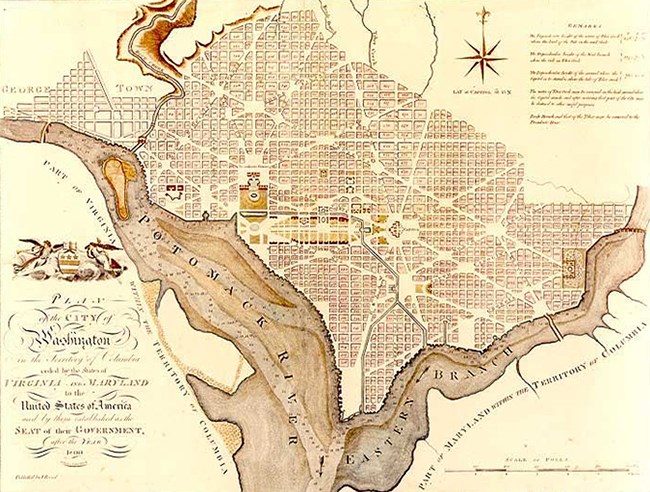Part of a series of articles titled History and Archeology of the District of Columbia Monumental Core.
Previous: The L'Enfant Plan
Next: The 17th Street Wharf
Article

NPS
by Charles LeeDecker
A ground breaking ceremony for the canal was held on May 2, 1810, featuring a team of six horses drawing a plow that cut a furrow 10 inches deep and 18 inches wide. Much more excavation would be required, as the canal’s charter specified that the canal would be 80 feet wide and allow for passage of boats drawing at least 3 feet of water. The canal enjoyed a brief period of success after opening in 1815, but problems arose almost immediately, as the canal channel became impassible at low tide because of siltation, and financial difficulties increased.
The city purchased the canal from its private owners in 1831, convinced that it was necessary for development of the downtown area. The city also invested in the C&O Canal Company and with the leverage of its financial stake in the C&O, forced the C&O to construct an extension from its existing terminus in Georgetown to western end of the Washington City Canal at 17th Street. The C&O Canal Extension was completed in 1832, following a route from the basin on Rock Creek near H Street, cutting through Easby’s Point to near 22nd Street, and then following the shoreline to the wharf at 17th Street. With the drop in elevation below Georgetown, two locks were necessary: one that opened from the canal to the Potomac River between H and I Streets (Lock A), and a second at 17th Street (Lock B). The lockkeeper’s house at Lock B was completed in 1837, built according to one of the standard plans for lockkeeper’s houses on the C&O Canal.
Despite the connection to the C&O, the Washington City Canal’s problems continued, and a series of deadlines for completion and improvements were missed. Problems with drainage and siltation brought forth all manner of recommendations for improvement, along with more and more public criticism. Although intended as a vital transportation link, the canal essentially functioned as an open sewer that collected the waste of the developing downtown area. By the end of the Civil War, the canal’s utility was being eclipsed by its threat to public health.
With assignment of responsibility for the public grounds to the Office of Public Buildings and Grounds (OPB&G) in 1867, Major Nathaniel Michler of the Corps of Engineers prepared annual reports that detailed the condition of public lands and urban infrastructure. Michler’s descriptions of the canal, repeated with some variation in each annual report, ranged from the sensational to the scientific.
It is the main artery of the sewerage of the largest part of the city, it being the receptacle not only of the excrement and sediment of the sewers, but also of the surface drainage. In addition to this an immense quantity of material is washed into it at every heavy rain by the Tiber. No one can appreciate the large amount of deposits thus formed except by actual examination (Michler 1867a:526).
Michler observed that the canal was designed to serve the dual purposes of a canal and a sewer but it served neither function well; because a canal should be almost level and a sewer should have a slope, the “pestiferous ditch” was a failure at both. Michler recommended construction of a separate, covered sewer in a parallel channel or abandoning the canal entirely.
Michler had less success in his proposed repairs to the canal, but his survey for a new presidential mansion is credited as the impetus for the creation Rock Creek Park. In his first report to Congress (Michler 1867b), Michler called attention to the valley’s natural features and picturesque scenery, at one point referring to Rock Creek as “bold, rocky, and picturesque.” Michler’s vision for creation of a park in the Rock Creek Valley proved to be as far-sighted as his time in Washington was short. In December 1871 Michler was transferred to the Military Division of the Pacific with only 12 days’ notice; Congressional authorization for the creation of Rock Creek Park did not occur until March 1889 (Mackintosh 1985).
Responsibility for the canal was transferred to the newly created Board of Public Works (BPW) in 1871, and the BPW quickly decided the canal would be filled. A key member of the BPW, Alexander Robey “Boss” Shepherd played an instrumental role in the filling of the canal. Where others had advocated dredging or covering the canal, Shepherd, a plumber by trade, transformed it to a sewer. After the canal was transformed into the B Street Sewer, it would be paved over; B Street was ultimately transformed into Constitution Avenue.
Michler, Nathaniel. 1867a. Communication of N. Michler, Major, of Engineers, Office of Public Buildings and Grounds, to the Chairman of the Committee on Public Buildings and Grounds. 39th Congress, 2nd Session. U.S. Senate. Miscellaneous Document No. 21. Government Printing Office, Washington, D.C.
Michler, Nathaniel. 1867b. Communication of N. Michler, Major, of Engineers, Office of Public Buildings and Grounds, to the Chairman of the Committee on Public Buildings and Grounds. Report of the Secretary of War, Appendix T. 40th Congress, 2nd Session. Executive Document No. 1, Volume 1325. Government Printing Office, Washington, D.C.
Mackintosh, Barry. 1985. Whence the Park. Rock Creek Park: An Administrative History. National Park Service, Washington, D.C. Accessed online March 31, 2004, at https://irma.nps.gov/DataStore/Reference/Profile/2194952.
Part of a series of articles titled History and Archeology of the District of Columbia Monumental Core.
Previous: The L'Enfant Plan
Next: The 17th Street Wharf
Last updated: April 17, 2020